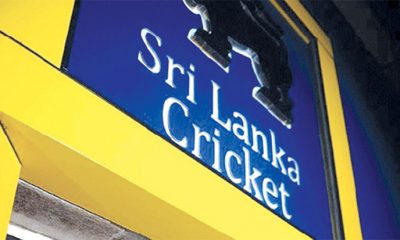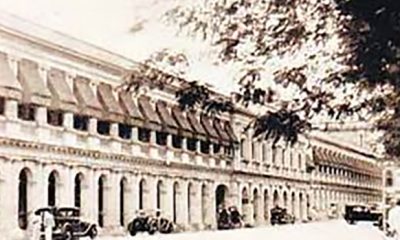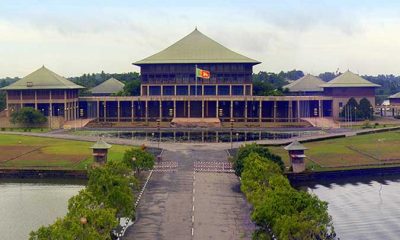Features
Sports Law reforms – lessons for the present and for the future

By Nuwan Peiris
Constitutions of National Sports Associations of all nations are the last bastions of aristocracy – and it is time to move on!
Proposes an Independent Sports Investigation and Inquiry Commission in line with Australian law
Proposes the power to issue directives by the DG of the Department of Sports to all National Sports Association
Apply the Right to Information Act to all Sports Associations
In Sri Lanka, sports, at many levels are becoming thriving commercial investments. And for those who have dedicated their lives tor various sports want them to be developed as a viable commercial industry. But do we have a proper regulatory system for that in Sri Lanka? Is the existing Sports Law – promulgated way back in 1973, amended in 1993, 1998 and 2005 – sufficient to develop sports as a commercial industry and support those who engage in sports as a profession?
This write-up examines the implications of continuous corruption, abuse of power and mismanagement by national associations of sports in Sri Lanka, and what needs to be done to overcome this. For example, irregularities in foreign tours, questionable spending and lack of accountability, favouritism and many other issues have become rampant notwithstanding the recent regulations passed by the Sports Minister.
At the end of this article the writer proposes urgent legal reforms that should be introduced to arrest this situation of serious mismanagement. He proposes the following; (1) an Independent Sports Investigation and Inquiry Commission, (2) the power to issue directives by the Director General to all national sports associations to surrender documents and disclose all decisions made by such bodies, (3) to make applicable the Right to Information Act, mutatis mutandis, to all sports associations notwithstanding such bodies being non-public bodies.
There is a caveat in these proposals. These proposals reflect the irreducible minimum that Parliament can legislate until such time a parliamentary select committee is appointed to formulate much more comprehensive Sports Regulatory Act, where the powers are similar to those in Australia – if not better.
The Sri Lanka Cricket Board Controversy
The National Audit Service Commission (NASC) initiated investigations under the leadership of a retired High Court Judge on irregularities involving the Sri Lanka Cricket Board. The news surrounding the reports/draft reports caused much consternation among the public. It is commendable to note the initiative taken by the Auditor General to appoint a committee headed by a retired High Court Judge to investigate such anomalies and mismanagement of the cricket board. The question now is the next legal steps that would be taken by the powers that be. However, the members of the public needs to have access to the full report. It is best that the Auditor General presents his report to Parliament, or an MP calls for its presentation.
It needs to be observed that while the Cricket Board has got much attention in the context of the popularity of the game, it is also important that similar interest is shown where other sports are concerned. The livelihoods of so many sportsmen, coaches and other support staff depend on the proper functioning of the various sports bodies.
Why we need a Sports Investigation and Inquiry Commission?
The important point here is that an independent sports body or commission is available to aggrieved parties to lodge complaints so that malpractices of national sports associations can be investigated. It is in this context, that the writer proposes a Sports Investigation and Inquiry Commission (SIIC) to investigate and inquire into corruption and malpractices of the national sports associations.
The jurisdiction of such a SIIC can be broad. It will include, but not be limited to;
(1) review of terms of player contracts, which includes contracts for coaches and other support staff
(2) investigate and inquire into corruption and malpractices of sports associations etc.,
Parallel to such reforms, more power should be given to the DG of Sports as the regulator to intervene on such matters like malpractices. Such directives should be wide enough to summon documents, resolutions etc, and upon finding any irregularities that come within the jurisdiction, the DG, if he so wishes, can submit such matters to the SIIC for further investigations and orders.
Another important aspect is to make applicable the Right to Information Act, mutatis mutandis, to all sports associations notwithstanding such bodies being non-public bodies.
The Regulatory Dilemma in Sports Law
Some governing bodies of national sports associations are one of the last bastions of the aristocracy. Some aristocrats – and self-proclaimed aristocrats – use their sports association positions to climb the social ladder, a phenomenon that is common in many countries. They converge into such places, like an irremovable barnacle attached to a ship’s hull, for their own social glory. They do not act in the best interests of the sports associations they represent nor their commercial success and continue in office even at a ripe old age. This is a common feature in many countries.
This dilemma is reflected in the legislation governing sports bodies in many countries. The governing bodies of these national sports associations are elected from those who manage the sports clubs – and all those sports associations’ constitutions bear evidence of this fact. The sports associations thereafter act as the regulator of the sport, thus controlling the entire fate of the sport in line with the wishes of their returning bodies, namely the sports clubs. Anyone who crosses the path of the politics and social norms of such ‘sports clubs’ will certainly earn the wrath of the governing sports bodies and are dealt with swiftly, effectively and ferociously.
This is a curious proposition to a legal mind. Because according to the legal theory – or more precisely, administrative law and public law principles – a regulatory body must have a considerable degree of independence from the industry which it seeks to police/supervise. For example, in order to regulate the banking industry, banks do not elect the regulator. The central bank here or the federal reserve (in the US) are independent bodies unconnected to the commercial banks they regulate. Central bank regulatory appointments are generally, statutorily vetted by an independent process. Similarly, the Director General of Merchant Shipping who acts as the regulator of the merchant shipping sector is not elected by the shipping community. The appointment is a separate process. But the sports governing bodies are different.
Take the following provision – section 29 – from Sports Law No. 25 of 1973, as amended;
Registration of National Associations of Sports
29. When a sport or group of sports is named by an Order under section 28-
(a) any National Association of such sport or group of sports, which is in existence at the time such Order is made, shall, within three months of the publication of such Order in the Gazette, apply for registration in accordance with the succeeding provisions of this Law; and
The relevant national association, notwithstanding its national status being granted, is still in the hands of private persons when it come to managing the sports.
The survival of the archaic law
All this had been fine long years ago when sports was the past time of the social elite. When sports came down to the middle and lower social classes and transformed as a professional and commercial endeavour, there arose a necessity to regulate the sports. Many countries promulgated sports legislation, but did not disturb the grassroots structures of such sports administration where the governing members of the sports bodies are still elected from sports clubs – and clubs which, at times, represents sports as well as the social norms of that class/region.
To modestly counter balance such broad based politics of sports associations, sports legislation around the world did not therefore substitute sports associations controlling power with a government appointed independent regulator. This would have been suicidal for any political party in any country.
However, this was not the case in other fields like the banking, shipping, telecommunication etc. Many historic and economic events led to the creation of independent regulators in these fields. But sports legislation did not follow suit.
The government appointed sports regulator in Sri Lanka is the Director General of Sports; and he, quite often takes a back stage when come to managing sports associations. His policing powers are significantly less compared to the powers of the central bank regulator or the merchant shipping regulator. The question here is whether the government appointed regulator for sports is no better than the Registrar of Companies under the Companies Act or the land registry?
In order to counter balance the overwhelming power of the national sports associations and its far-reaching effects on sports and perople’s lives, countries like Australia introduced a Sports Commission. The Australian Sports Commission (ASC) is the Australian Government agency responsible for supporting and investing in sport at all levels. The ASC was established in 1985 under the Australian Sports Commission Act 1989 and functions in accordance with the Public Governance, Performance and Accountability Act 2013.
But the drawback is that such independent commissions are reactive and comes into the picture after an appeal or a complaint; and, most definitely, do not get involved in the day to day administration of the sports bodies as a regulator – but nevertheless, as an immediate measure, the writer propose this system as a compromise until we find a permanent solution.
Some thoughts for the future
Finally, it is the time to revamp the old sports law and start to think afresh – and a good starting point will be to consider the Australian Sports Commission Act 1989. We must have the courage to formulate laws to establish independently appointed regulators through an independent statutory vetting body to replace the existing sports associations to govern each sport, rather than allowing the sports sector run by those elected by their own clubs to ‘so- called’ national sports associations – based on the constitutions written by, in some occasions, cloistered groups for their self-serving interests.
(The writer is an Attorney, Chartered Shipbroker (UK) and UN-ITLOS Nippon Fellow 2012/2013. He holds M.Sc. Logistics (BCU-UK), LL.M (International Maritime Law) (IMO-IMLI), LL. M (International Trade Law) (Wales), LL.B (O.U.S.L). For comments, please write to nuwanpeiris.lawyer@gmail.com )
Features
The heart-friendly health minister

by Dr Gotabhya Ranasinghe
Senior Consultant Cardiologist
National Hospital Sri Lanka
When we sought a meeting with Hon Dr. Ramesh Pathirana, Minister of Health, he graciously cleared his busy schedule to accommodate us. Renowned for his attentive listening and deep understanding, Minister Pathirana is dedicated to advancing the health sector. His openness and transparency exemplify the qualities of an exemplary politician and minister.
Dr. Palitha Mahipala, the current Health Secretary, demonstrates both commendable enthusiasm and unwavering support. This combination of attributes makes him a highly compatible colleague for the esteemed Minister of Health.
Our discussion centered on a project that has been in the works for the past 30 years, one that no other minister had managed to advance.
Minister Pathirana, however, recognized the project’s significance and its potential to revolutionize care for heart patients.
The project involves the construction of a state-of-the-art facility at the premises of the National Hospital Colombo. The project’s location within the premises of the National Hospital underscores its importance and relevance to the healthcare infrastructure of the nation.
This facility will include a cardiology building and a tertiary care center, equipped with the latest technology to handle and treat all types of heart-related conditions and surgeries.
Securing funding was a major milestone for this initiative. Minister Pathirana successfully obtained approval for a $40 billion loan from the Asian Development Bank. With the funding in place, the foundation stone is scheduled to be laid in September this year, and construction will begin in January 2025.
This project guarantees a consistent and uninterrupted supply of stents and related medications for heart patients. As a result, patients will have timely access to essential medical supplies during their treatment and recovery. By securing these critical resources, the project aims to enhance patient outcomes, minimize treatment delays, and maintain the highest standards of cardiac care.
Upon its fruition, this monumental building will serve as a beacon of hope and healing, symbolizing the unwavering dedication to improving patient outcomes and fostering a healthier society.We anticipate a future marked by significant progress and positive outcomes in Sri Lanka’s cardiovascular treatment landscape within the foreseeable timeframe.
Features
A LOVING TRIBUTE TO JESUIT FR. ALOYSIUS PIERIS ON HIS 90th BIRTHDAY

by Fr. Emmanuel Fernando, OMI
Jesuit Fr. Aloysius Pieris (affectionately called Fr. Aloy) celebrated his 90th birthday on April 9, 2024 and I, as the editor of our Oblate Journal, THE MISSIONARY OBLATE had gone to press by that time. Immediately I decided to publish an article, appreciating the untiring selfless services he continues to offer for inter-Faith dialogue, the renewal of the Catholic Church, his concern for the poor and the suffering Sri Lankan masses and to me, the present writer.
It was in 1988, when I was appointed Director of the Oblate Scholastics at Ampitiya by the then Oblate Provincial Fr. Anselm Silva, that I came to know Fr. Aloy more closely. Knowing well his expertise in matters spiritual, theological, Indological and pastoral, and with the collaborative spirit of my companion-formators, our Oblate Scholastics were sent to Tulana, the Research and Encounter Centre, Kelaniya, of which he is the Founder-Director, for ‘exposure-programmes’ on matters spiritual, biblical, theological and pastoral. Some of these dimensions according to my view and that of my companion-formators, were not available at the National Seminary, Ampitiya.
Ever since that time, our Oblate formators/ accompaniers at the Oblate Scholasticate, Ampitiya , have continued to send our Oblate Scholastics to Tulana Centre for deepening their insights and convictions regarding matters needed to serve the people in today’s context. Fr. Aloy also had tried very enthusiastically with the Oblate team headed by Frs. Oswald Firth and Clement Waidyasekara to begin a Theologate, directed by the Religious Congregations in Sri Lanka, for the contextual formation/ accompaniment of their members. It should very well be a desired goal of the Leaders / Provincials of the Religious Congregations.
Besides being a formator/accompanier at the Oblate Scholasticate, I was entrusted also with the task of editing and publishing our Oblate journal, ‘The Missionary Oblate’. To maintain the quality of the journal I continue to depend on Fr. Aloy for his thought-provoking and stimulating articles on Biblical Spirituality, Biblical Theology and Ecclesiology. I am very grateful to him for his generous assistance. Of late, his writings on renewal of the Church, initiated by Pope St. John XX111 and continued by Pope Francis through the Synodal path, published in our Oblate journal, enable our readers to focus their attention also on the needed renewal in the Catholic Church in Sri Lanka. Fr. Aloy appreciated very much the Synodal path adopted by the Jesuit Pope Francis for the renewal of the Church, rooted very much on prayerful discernment. In my Religious and presbyteral life, Fr.Aloy continues to be my spiritual animator / guide and ongoing formator / acccompanier.
Fr. Aloysius Pieris, BA Hons (Lond), LPh (SHC, India), STL (PFT, Naples), PhD (SLU/VC), ThD (Tilburg), D.Ltt (KU), has been one of the eminent Asian theologians well recognized internationally and one who has lectured and held visiting chairs in many universities both in the West and in the East. Many members of Religious Congregations from Asian countries have benefited from his lectures and guidance in the East Asian Pastoral Institute (EAPI) in Manila, Philippines. He had been a Theologian consulted by the Federation of Asian Bishops’ Conferences for many years. During his professorship at the Gregorian University in Rome, he was called to be a member of a special group of advisers on other religions consulted by Pope Paul VI.
Fr. Aloy is the author of more than 30 books and well over 500 Research Papers. Some of his books and articles have been translated and published in several countries. Among those books, one can find the following: 1) The Genesis of an Asian Theology of Liberation (An Autobiographical Excursus on the Art of Theologising in Asia, 2) An Asian Theology of Liberation, 3) Providential Timeliness of Vatican 11 (a long-overdue halt to a scandalous millennium, 4) Give Vatican 11 a chance, 5) Leadership in the Church, 6) Relishing our faith in working for justice (Themes for study and discussion), 7) A Message meant mainly, not exclusively for Jesuits (Background information necessary for helping Francis renew the Church), 8) Lent in Lanka (Reflections and Resolutions, 9) Love meets wisdom (A Christian Experience of Buddhism, 10) Fire and Water 11) God’s Reign for God’s poor, 12) Our Unhiddden Agenda (How we Jesuits work, pray and form our men). He is also the Editor of two journals, Vagdevi, Journal of Religious Reflection and Dialogue, New Series.
Fr. Aloy has a BA in Pali and Sanskrit from the University of London and a Ph.D in Buddhist Philosophy from the University of Sri Lankan, Vidyodaya Campus. On Nov. 23, 2019, he was awarded the prestigious honorary Doctorate of Literature (D.Litt) by the Chancellor of the University of Kelaniya, the Most Venerable Welamitiyawe Dharmakirthi Sri Kusala Dhamma Thera.
Fr. Aloy continues to be a promoter of Gospel values and virtues. Justice as a constitutive dimension of love and social concern for the downtrodden masses are very much noted in his life and work. He had very much appreciated the commitment of the late Fr. Joseph (Joe) Fernando, the National Director of the Social and Economic Centre (SEDEC) for the poor.
In Sri Lanka, a few religious Congregations – the Good Shepherd Sisters, the Christian Brothers, the Marist Brothers and the Oblates – have invited him to animate their members especially during their Provincial Congresses, Chapters and International Conferences. The mainline Christian Churches also have sought his advice and followed his seminars. I, for one, regret very much, that the Sri Lankan authorities of the Catholic Church –today’s Hierarchy—- have not sought Fr.
Aloy’s expertise for the renewal of the Catholic Church in Sri Lanka and thus have not benefited from the immense store of wisdom and insight that he can offer to our local Church while the Sri Lankan bishops who governed the Catholic church in the immediate aftermath of the Second Vatican Council (Edmund Fernando OMI, Anthony de Saram, Leo Nanayakkara OSB, Frank Marcus Fernando, Paul Perera,) visited him and consulted him on many matters. Among the Tamil Bishops, Bishop Rayappu Joseph was keeping close contact with him and Bishop J. Deogupillai hosted him and his team visiting him after the horrible Black July massacre of Tamils.
Features
A fairy tale, success or debacle

Sri Lanka-Singapore Free Trade Agreement
By Gomi Senadhira
senadhiragomi@gmail.com
“You might tell fairy tales, but the progress of a country cannot be achieved through such narratives. A country cannot be developed by making false promises. The country moved backward because of the electoral promises made by political parties throughout time. We have witnessed that the ultimate result of this is the country becoming bankrupt. Unfortunately, many segments of the population have not come to realize this yet.” – President Ranil Wickremesinghe, 2024 Budget speech
Any Sri Lankan would agree with the above words of President Wickremesinghe on the false promises our politicians and officials make and the fairy tales they narrate which bankrupted this country. So, to understand this, let’s look at one such fairy tale with lots of false promises; Ranil Wickremesinghe’s greatest achievement in the area of international trade and investment promotion during the Yahapalana period, Sri Lanka-Singapore Free Trade Agreement (SLSFTA).
It is appropriate and timely to do it now as Finance Minister Wickremesinghe has just presented to parliament a bill on the National Policy on Economic Transformation which includes the establishment of an Office for International Trade and the Sri Lanka Institute of Economics and International Trade.
Was SLSFTA a “Cleverly negotiated Free Trade Agreement” as stated by the (former) Minister of Development Strategies and International Trade Malik Samarawickrama during the Parliamentary Debate on the SLSFTA in July 2018, or a colossal blunder covered up with lies, false promises, and fairy tales? After SLSFTA was signed there were a number of fairy tales published on this agreement by the Ministry of Development Strategies and International, Institute of Policy Studies, and others.
However, for this article, I would like to limit my comments to the speech by Minister Samarawickrama during the Parliamentary Debate, and the two most important areas in the agreement which were covered up with lies, fairy tales, and false promises, namely: revenue loss for Sri Lanka and Investment from Singapore. On the other important area, “Waste products dumping” I do not want to comment here as I have written extensively on the issue.
1. The revenue loss
During the Parliamentary Debate in July 2018, Minister Samarawickrama stated “…. let me reiterate that this FTA with Singapore has been very cleverly negotiated by us…. The liberalisation programme under this FTA has been carefully designed to have the least impact on domestic industry and revenue collection. We have included all revenue sensitive items in the negative list of items which will not be subject to removal of tariff. Therefore, 97.8% revenue from Customs duty is protected. Our tariff liberalisation will take place over a period of 12-15 years! In fact, the revenue earned through tariffs on goods imported from Singapore last year was Rs. 35 billion.
The revenue loss for over the next 15 years due to the FTA is only Rs. 733 million– which when annualised, on average, is just Rs. 51 million. That is just 0.14% per year! So anyone who claims the Singapore FTA causes revenue loss to the Government cannot do basic arithmetic! Mr. Speaker, in conclusion, I call on my fellow members of this House – don’t mislead the public with baseless criticism that is not grounded in facts. Don’t look at petty politics and use these issues for your own political survival.”
I was surprised to read the minister’s speech because an article published in January 2018 in “The Straits Times“, based on information released by the Singaporean Negotiators stated, “…. With the FTA, tariff savings for Singapore exports are estimated to hit $10 million annually“.
As the annual tariff savings (that is the revenue loss for Sri Lanka) calculated by the Singaporean Negotiators, Singaporean $ 10 million (Sri Lankan rupees 1,200 million in 2018) was way above the rupees’ 733 million revenue loss for 15 years estimated by the Sri Lankan negotiators, it was clear to any observer that one of the parties to the agreement had not done the basic arithmetic!
Six years later, according to a report published by “The Morning” newspaper, speaking at the Committee on Public Finance (COPF) on 7th May 2024, Mr Samarawickrama’s chief trade negotiator K.J. Weerasinghehad had admitted “…. that forecasted revenue loss for the Government of Sri Lanka through the Singapore FTA is Rs. 450 million in 2023 and Rs. 1.3 billion in 2024.”
If these numbers are correct, as tariff liberalisation under the SLSFTA has just started, we will pass Rs 2 billion very soon. Then, the question is how Sri Lanka’s trade negotiators made such a colossal blunder. Didn’t they do their basic arithmetic? If they didn’t know how to do basic arithmetic they should have at least done their basic readings. For example, the headline of the article published in The Straits Times in January 2018 was “Singapore, Sri Lanka sign FTA, annual savings of $10m expected”.
Anyway, as Sri Lanka’s chief negotiator reiterated at the COPF meeting that “…. since 99% of the tariffs in Singapore have zero rates of duty, Sri Lanka has agreed on 80% tariff liberalisation over a period of 15 years while expecting Singapore investments to address the imbalance in trade,” let’s turn towards investment.
Investment from Singapore
In July 2018, speaking during the Parliamentary Debate on the FTA this is what Minister Malik Samarawickrama stated on investment from Singapore, “Already, thanks to this FTA, in just the past two-and-a-half months since the agreement came into effect we have received a proposal from Singapore for investment amounting to $ 14.8 billion in an oil refinery for export of petroleum products. In addition, we have proposals for a steel manufacturing plant for exports ($ 1 billion investment), flour milling plant ($ 50 million), sugar refinery ($ 200 million). This adds up to more than $ 16.05 billion in the pipeline on these projects alone.
And all of these projects will create thousands of more jobs for our people. In principle approval has already been granted by the BOI and the investors are awaiting the release of land the environmental approvals to commence the project.
I request the Opposition and those with vested interests to change their narrow-minded thinking and join us to develop our country. We must always look at what is best for the whole community, not just the few who may oppose. We owe it to our people to courageously take decisions that will change their lives for the better.”
According to the media report I quoted earlier, speaking at the Committee on Public Finance (COPF) Chief Negotiator Weerasinghe has admitted that Sri Lanka was not happy with overall Singapore investments that have come in the past few years in return for the trade liberalisation under the Singapore-Sri Lanka Free Trade Agreement. He has added that between 2021 and 2023 the total investment from Singapore had been around $162 million!
What happened to those projects worth $16 billion negotiated, thanks to the SLSFTA, in just the two-and-a-half months after the agreement came into effect and approved by the BOI? I do not know about the steel manufacturing plant for exports ($ 1 billion investment), flour milling plant ($ 50 million) and sugar refinery ($ 200 million).
However, story of the multibillion-dollar investment in the Petroleum Refinery unfolded in a manner that would qualify it as the best fairy tale with false promises presented by our politicians and the officials, prior to 2019 elections.
Though many Sri Lankans got to know, through the media which repeatedly highlighted a plethora of issues surrounding the project and the questionable credentials of the Singaporean investor, the construction work on the Mirrijiwela Oil Refinery along with the cement factory began on the24th of March 2019 with a bang and Minister Ranil Wickremesinghe and his ministers along with the foreign and local dignitaries laid the foundation stones.
That was few months before the 2019 Presidential elections. Inaugurating the construction work Prime Minister Ranil Wickremesinghe said the projects will create thousands of job opportunities in the area and surrounding districts.
The oil refinery, which was to be built over 200 acres of land, with the capacity to refine 200,000 barrels of crude oil per day, was to generate US$7 billion of exports and create 1,500 direct and 3,000 indirect jobs. The construction of the refinery was to be completed in 44 months. Four years later, in August 2023 the Cabinet of Ministers approved the proposal presented by President Ranil Wickremesinghe to cancel the agreement with the investors of the refinery as the project has not been implemented! Can they explain to the country how much money was wasted to produce that fairy tale?
It is obvious that the President, ministers, and officials had made huge blunders and had deliberately misled the public and the parliament on the revenue loss and potential investment from SLSFTA with fairy tales and false promises.
As the president himself said, a country cannot be developed by making false promises or with fairy tales and these false promises and fairy tales had bankrupted the country. “Unfortunately, many segments of the population have not come to realize this yet”.
(The writer, a specialist and an activist on trade and development issues . )
























